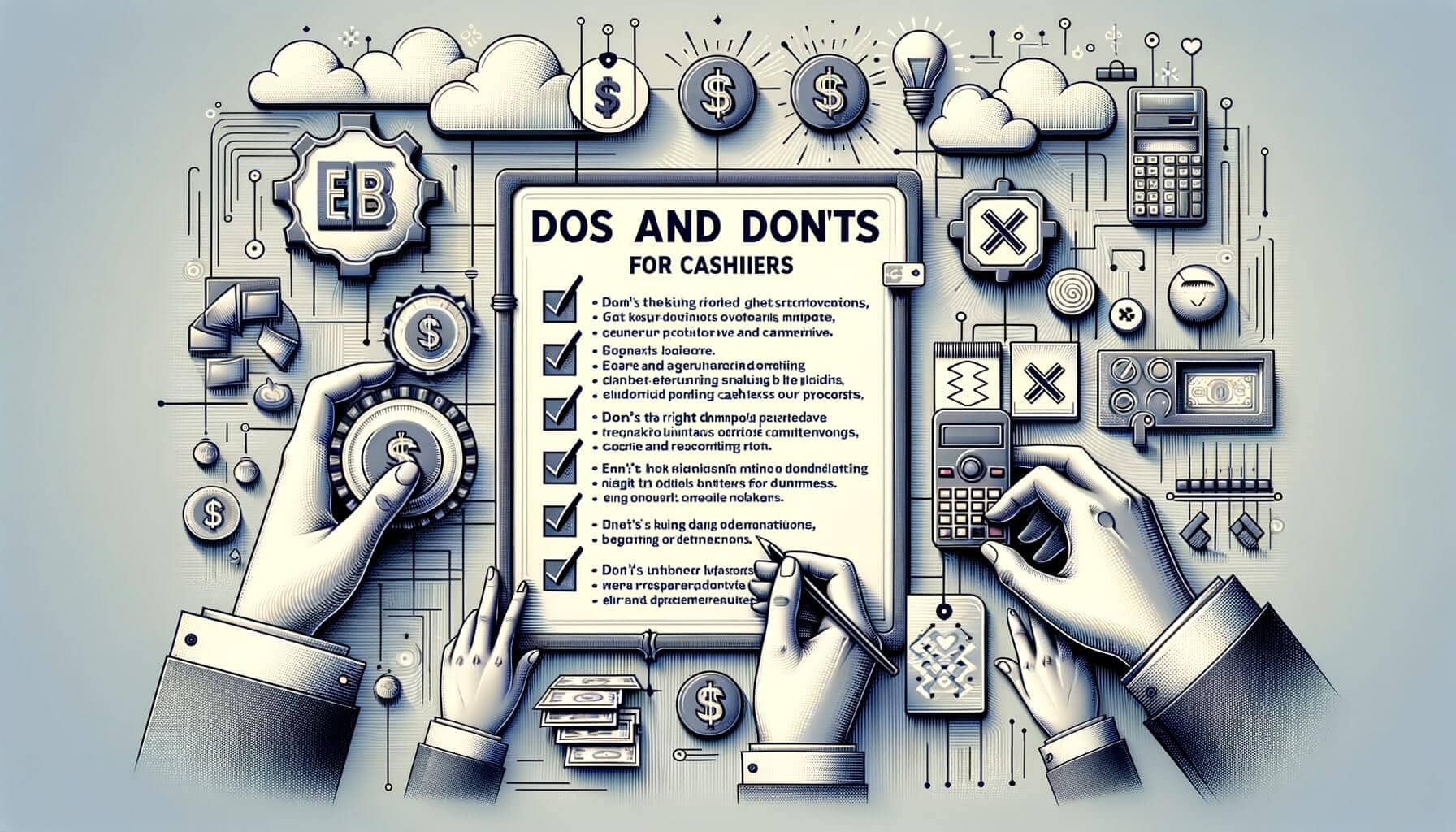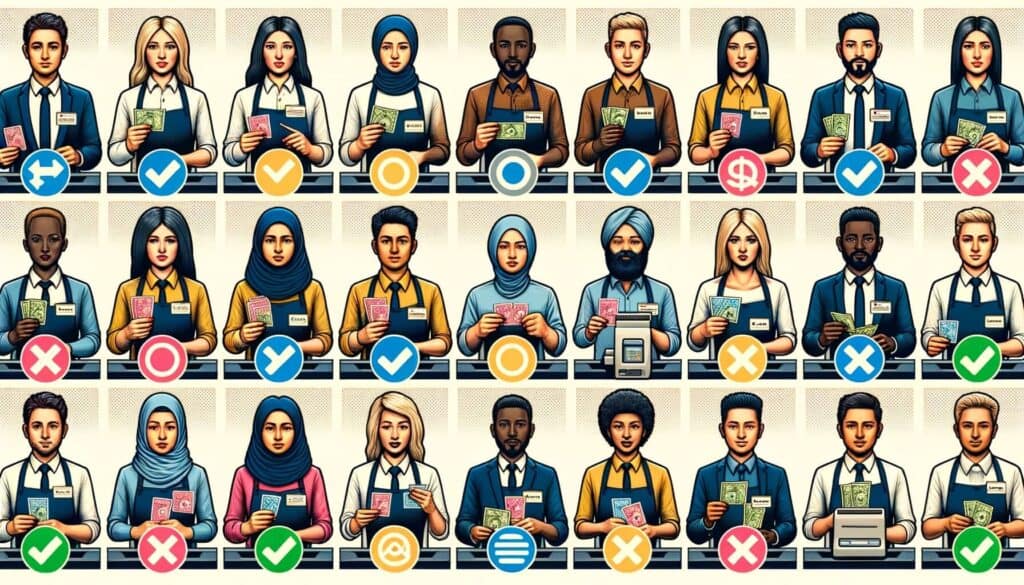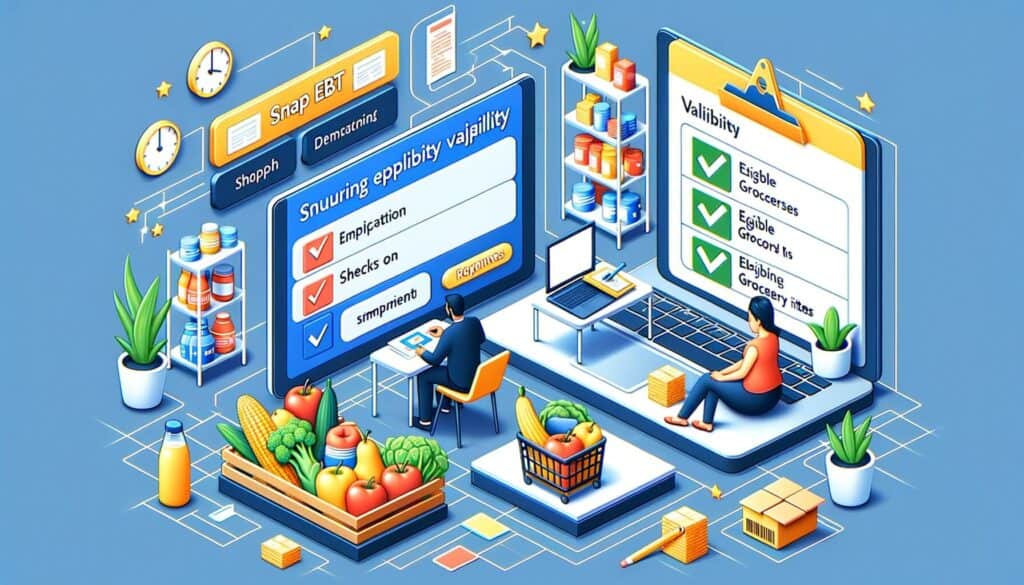
By admin April 16, 2025
The Supplemental Nutrition Assistance Program (SNAP) is a federal assistance program in the United States that provides eligible low-income individuals and families with funds to purchase food. The Electronic Benefit Transfer (EBT) system is the method through which SNAP benefits are distributed and accessed. EBT cards are issued to eligible participants, who can use them to purchase eligible food items at authorized retailers.
As a cashier, it is crucial to understand the SNAP EBT program and follow certain guidelines to ensure smooth transactions and compliance with program rules. In this article, we will explore the do’s and don’ts for cashiers when accepting SNAP EBT payments, as well as provide a detailed guide for each aspect of the process.
Understanding the SNAP EBT Program
Before delving into the do’s and don’ts, it is essential to have a comprehensive understanding of the SNAP EBT program. SNAP is the largest federal assistance program aimed at combating hunger and improving nutrition among low-income individuals and families. It is administered by the United States Department of Agriculture (USDA) and provides benefits to over 40 million people each month.
The EBT system was introduced in the 1990s to replace the traditional paper food stamp system. EBT cards function like debit cards, allowing participants to access their benefits electronically. The funds are loaded onto the EBT card each month, and participants can use them to purchase eligible food items at authorized retailers, including grocery stores, supermarkets, and farmers markets.
Do’s for Cashiers when Accepting SNAP EBT Payments

As a cashier, there are several important do’s to keep in mind when accepting SNAP EBT payments. These guidelines will help ensure a smooth transaction process and compliance with program rules:
1. Verify the EBT card: When a customer presents an EBT card for payment, it is crucial to verify its authenticity. Look for the USDA or state agency logo on the card, as well as the cardholder’s name and photo. Ensure that the card is not expired and matches the customer’s identification.
2. Familiarize yourself with eligible items: SNAP benefits can only be used to purchase certain food items. Familiarize yourself with the list of eligible items, which includes fruits, vegetables, dairy products, meat, poultry, fish, bread, and cereals. Non-food items, such as alcohol, tobacco, pet food, and hot prepared foods, are not eligible for purchase with SNAP benefits.
3. Follow the purchase restrictions: SNAP benefits cannot be used to purchase certain items, such as alcohol, tobacco, vitamins, supplements, and hot prepared foods. Ensure that customers are not attempting to purchase these restricted items with their EBT card.
4. Handle the EBT transaction discreetly: Respect the privacy of SNAP participants by handling EBT transactions discreetly. Avoid making any comments or judgments about the use of EBT cards, as it is a sensitive topic for many individuals and families.
5. Provide excellent customer service: Treat SNAP participants with the same level of respect and courtesy as any other customer. Offer assistance if needed and answer any questions they may have about the transaction process or eligible items.
6. Be patient and understanding: Some SNAP participants may be unfamiliar with the EBT system or face challenges during the transaction process. Be patient and understanding, providing guidance and support as needed.
7. Keep the EBT terminal secure: Ensure that the EBT terminal is secure and protected from unauthorized access. Do not share your login credentials or allow others to use the terminal without proper authorization.
8. Maintain accurate records: Keep accurate records of EBT transactions, including the date, time, amount, and items purchased. This information may be required for auditing purposes or in case of any discrepancies.
9. Stay updated on program changes: The SNAP EBT program undergoes periodic updates and changes. Stay informed about any modifications to program rules, eligible items, or transaction procedures to ensure compliance.
10. Seek assistance when needed: If you encounter any issues or have questions regarding SNAP EBT transactions, do not hesitate to seek assistance from your supervisor or the appropriate authority. It is better to clarify any doubts than to make mistakes that could impact program integrity.
Don’ts for Cashiers when Accepting SNAP EBT Payments

While there are several do’s to follow, it is equally important to be aware of the don’ts when accepting SNAP EBT payments. Avoiding these pitfalls will help maintain program integrity and ensure a smooth transaction process:
1. Do not accept expired EBT cards: SNAP EBT cards have an expiration date printed on them. Do not accept cards that have expired, as they are no longer valid for use. Advise the customer to contact their local SNAP office for a replacement card.
2. Do not accept damaged or altered EBT cards: If an EBT card appears to be damaged or altered, do not accept it as a form of payment. Look for signs of tampering, such as scratches, cracks, or changes in the card’s appearance. If in doubt, ask the customer for an alternative form of payment or direct them to their local SNAP office for assistance.
3. Do not allow unauthorized individuals to use an EBT card: EBT cards are issued to specific individuals and should not be used by anyone else. Do not allow customers to use someone else’s EBT card, even if they claim to have permission. This is considered fraud and can have serious consequences.
4. Do not split transactions: Splitting transactions refers to dividing a single purchase into multiple transactions to bypass purchase restrictions or exceed the available SNAP benefits. Do not engage in or facilitate split transactions, as it is against program rules and can result in penalties.
5. Do not provide cash back: SNAP benefits are intended for the purchase of eligible food items and cannot be used to obtain cash. Do not provide cash back to customers when they use their EBT card for payment.
6. Do not charge sales tax on eligible items: Eligible food items purchased with SNAP benefits are exempt from sales tax. Do not charge sales tax on these items during the transaction process. Familiarize yourself with the sales tax regulations in your state to ensure compliance.
7. Do not accept payment for ineligible items: SNAP benefits can only be used to purchase eligible food items. Do not accept payment with SNAP benefits for non-food items, such as alcohol, tobacco, vitamins, supplements, or hot prepared foods.
8. Do not engage in discriminatory practices: Treat all customers equally and avoid any form of discrimination based on race, ethnicity, gender, or any other protected characteristic. Provide the same level of service and respect to all SNAP participants.
9. Do not share confidential information: Respect the confidentiality of SNAP participants and do not share any personal or financial information obtained during the transaction process. This includes the customer’s EBT card number, PIN, or any other sensitive data.
10. Do not ignore program violations: If you suspect any fraudulent activity or program violations, do not ignore them. Report your concerns to your supervisor or the appropriate authority, providing as much detail as possible. Your vigilance can help maintain program integrity and protect the benefits of eligible participants.
Ensuring SNAP EBT Eligibility and Validity

As a cashier, it is essential to ensure the eligibility and validity of SNAP EBT transactions. This involves verifying the participant’s eligibility and confirming the validity of their EBT card. Here are the steps to follow:
1. Verify participant eligibility: Before accepting an EBT card for payment, verify the participant’s eligibility by checking their identification. SNAP benefits are only available to eligible individuals and families who meet specific income and resource requirements. Look for identification documents, such as a driver’s license or state-issued ID, to confirm the participant’s identity.
2. Check the EBT card for authenticity: Examine the EBT card for signs of authenticity. Look for the USDA or state agency logo, the cardholder’s name and photo, and any security features present on the card. Ensure that the card is not expired and matches the customer’s identification.
3. Confirm the card’s validity: Use the EBT terminal to confirm the validity of the card. Follow the prompts on the terminal to check the card’s balance and ensure that it is active. If the card is declined or shows a zero balance, inform the customer and advise them to contact their local SNAP office for assistance.
4. Verify the PIN: The Personal Identification Number (PIN) is a security measure used to access SNAP benefits. When the customer enters their PIN on the EBT terminal, ensure that it matches the one associated with the card. If the PIN is incorrect or the customer forgets their PIN, advise them to contact their local SNAP office for assistance.
5. Cross-check with the customer’s purchase: As the customer selects their eligible food items for purchase, cross-check them with the list of eligible items. Ensure that the items meet the program’s guidelines and are eligible for payment with SNAP benefits. If any ineligible items are included, inform the customer and ask them to provide an alternative form of payment for those items.
Handling SNAP EBT Transactions Correctly

Handling SNAP EBT transactions correctly is crucial to ensure compliance with program rules and maintain program integrity. Here is a step-by-step guide to handling SNAP EBT transactions:
1. Initiate the transaction: When the customer presents their EBT card for payment, initiate the transaction by selecting the EBT payment option on the terminal. Follow the prompts on the screen to proceed with the transaction.
2. Enter the transaction amount: Enter the total amount of the eligible food items selected by the customer. Ensure that the amount does not exceed the available balance on the EBT card. If the customer’s purchase exceeds their available balance, inform them of the remaining balance and ask for an alternative form of payment for the remaining amount.
3. Prompt for the customer’s PIN: Once the transaction amount is entered, prompt the customer to enter their PIN on the EBT terminal. Ensure that the customer enters their PIN securely and without any assistance.
4. Confirm the transaction: After the customer enters their PIN, the EBT terminal will process the transaction. Wait for the terminal to confirm the transaction and display the approval message. If the transaction is declined, inform the customer and ask them to contact their local SNAP office for assistance.
5. Provide a receipt: Once the transaction is approved, provide the customer with a receipt. The receipt should include the transaction details, such as the date, time, amount, and items purchased. Offer the receipt to the customer and keep a copy for your records.
6. Handle refunds or voids: In case of a refund or void, follow the specific procedures outlined by your store or employer. Ensure that the refund or void is processed correctly and does not impact the customer’s SNAP benefits.
7. Maintain accurate records: Keep accurate records of all SNAP EBT transactions, including the date, time, amount, and items purchased. This information may be required for auditing purposes or in case of any discrepancies.
Dealing with SNAP EBT Challenges and Difficulties
While most SNAP EBT transactions proceed smoothly, there may be challenges or difficulties that arise. As a cashier, it is important to be prepared to handle these situations effectively. Here are some common challenges and how to address them:
1. Insufficient balance: If a customer’s purchase exceeds their available SNAP benefits balance, inform them of the remaining balance and ask for an alternative form of payment for the remaining amount. Offer assistance in selecting eligible items within their available balance if needed.
2. Invalid EBT card: If an EBT card is declined or shows a zero balance, inform the customer and advise them to contact their local SNAP office for assistance. Do not accept the card as a form of payment if it is invalid or expired.
3. Forgotten PIN: If a customer forgets their PIN or enters an incorrect PIN, advise them to contact their local SNAP office for assistance. Do not allow them to proceed with the transaction without the correct PIN.
4. Ineligible items: If a customer attempts to purchase ineligible items with their EBT card, inform them that those items are not eligible for payment with SNAP benefits. Ask them to provide an alternative form of payment for those items.
5. System or terminal issues: In case of system or terminal issues, follow the specific procedures outlined by your store or employer. Seek assistance from your supervisor or the appropriate authority to resolve the issue promptly.
6. Language barriers: If you encounter a customer with limited English proficiency, try to communicate using simple and clear language. Use gestures or visual aids if necessary to assist them in understanding the transaction process.
7. Customer dissatisfaction: If a customer expresses dissatisfaction or frustration during the transaction process, remain calm and professional. Listen to their concerns and offer assistance or guidance to resolve the issue. If necessary, involve your supervisor or the appropriate authority to address the situation.
Frequently Asked Questions about SNAP EBT for Cashiers
Q1. Can SNAP benefits be used to purchase non-food items?
A1. No, SNAP benefits can only be used to purchase eligible food items. Non-food items, such as alcohol, tobacco, vitamins, supplements, and hot prepared foods, are not eligible for purchase with SNAP benefits.
Q2. Can customers split transactions to purchase restricted items?
A2. No, splitting transactions to bypass purchase restrictions or exceed the available SNAP benefits is against program rules. Cashiers should not engage in or facilitate split transactions.
Q3. What should I do if a customer’s EBT card is declined?
A3. If a customer’s EBT card is declined, inform them and advise them to contact their local SNAP office for assistance. Do not accept the card as a form of payment if it is declined or shows a zero balance.
Q4. Can customers receive cash back when using their EBT card?
A4. No, SNAP benefits are intended for the purchase of eligible food items and cannot be used to obtain cash. Cashiers should not provide cash back to customers when they use their EBT card for payment.
Q5. How can I ensure the privacy of SNAP participants during EBT transactions?
A5. Cashiers should handle EBT transactions discreetly to respect the privacy of SNAP participants. Avoid making any comments or judgments about the use of EBT cards and keep the transaction process confidential.
Conclusion
As a cashier, understanding the SNAP EBT program and following the do’s and don’ts for accepting SNAP EBT payments is crucial to ensure smooth transactions and accurate processing of payments.
By familiarizing yourself with the program guidelines, treating SNAP EBT customers with respect, verifying eligibility and validity, and handling transactions correctly, you can provide a positive experience for customers and contribute to the success of the SNAP EBT program in alleviating hunger and improving nutrition among low-income individuals and families.
Remember to stay informed about any changes or updates to the program and maintain the confidentiality of SNAP EBT transactions. By following these guidelines, you can play a vital role in supporting those in need and promoting food security in your community.